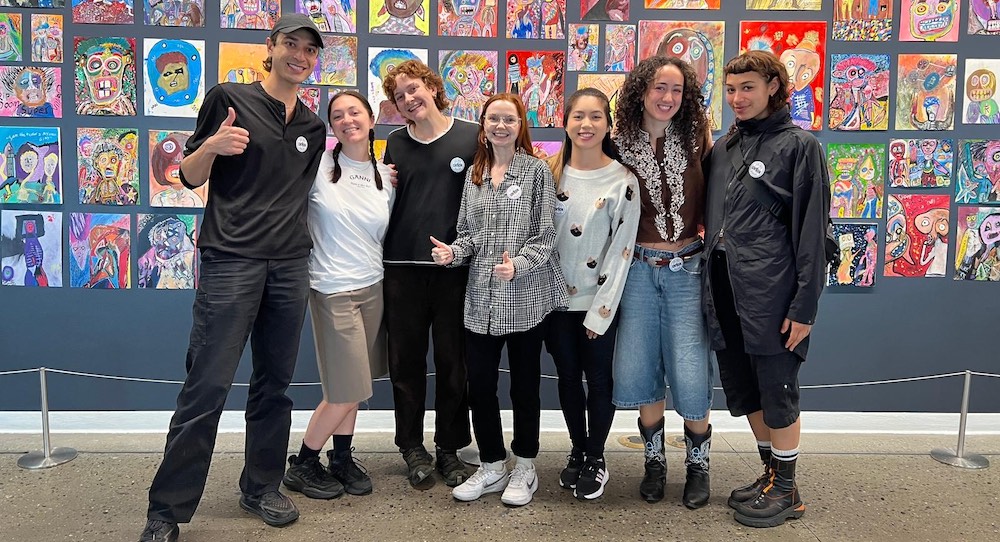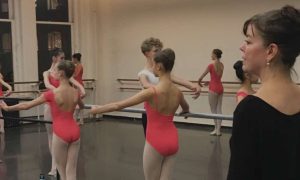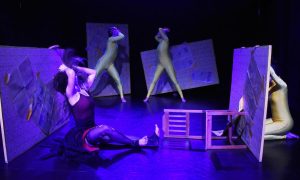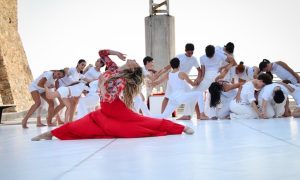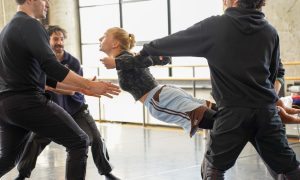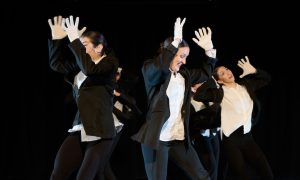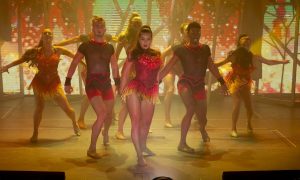The magic of live art happens through individuals of varied capacities and roles coming together toward a common goal. One could say the exact same of organizing a union. At New York Live Arts, three separate departments – Front of House, Production and the Dance Company – realized that joining as one entity could help them toward an important goal: advocating for themselves in the workplace.
From regular meetings to engaging with management to a petition on change.org, these arts professionals have taken intentional steps to form something that can fortify their rights as workers. Front of House worker Artie Ticknor gives us at Dance Informa a timeline of how it’s all happened. Company Dancer Shane Larson and Genevieve Martinez from the Production Department also give their perspectives. Let’s hear right from them!
The path to the union
Back in 2023, Front of House personnel had safety concerns related to their roles, Ticknor explains. They reported these concerns to Management, but were feeling unheard. So they decided to start taking action. In October, they contacted – and subsequently met with – EWOC (Emergency Workplace Organizing Committee), an organization that supports workers in these sorts of cases.
“We weren’t thinking about unionizing at that point, but we came to realize that the only way to be heard was to have power in numbers,” Ticknor recounts. Front of House personnel reached out to Company members and Production workers, to find that they had similar concerns. On June 14, 2023, individuals from all three departments met with Management through a Town Hall. Yet, they were still feeling unheard, and saw no steps taken toward meaningful changes.
That’s when they decided it was time to unionize. After not receiving voluntary recognition of the (independent) Live Arts Workers Union, they recruited a pro-bono lawyer. Management stipulated that they’d need to split up into their departments, or they’d go into a hearing with the National Labor Relations Board (NLRB). In order to not lose momentum with their campaign, the workers conceded, Ticknor explains. They didn’t join with another union because there’s not one already out there that encompasses all of their separate disciplines, they also note.
One downside of having those three separate units is that they can’t all strike at the same time, Ticknor says. They’ve also had to hold three different elections – with each having to conclude with a 50%+1 vote share. They’ve recently achieved that, as well as orchestrated a successful petition campaign in support of their union through change.org. After the elections, management recognized their union – certainly a big step. All of the above took eight months, Ticknor adds. Organizing a union is certainly no fast process.
Larson heard about the organizing effort in January 2024. His first reaction: “Of course I’ll support!” He notes that workers in the three departments know each other well, creating a camaraderie that’s been foundational for their efforts. “What happens to one of us affects all of us, as well as the work we do…everyone here is tightly connected,” Larson notes.
More specifically concerning the Company, recent incidents in rehearsal also demonstrated the need for more formal accountability structures and protections for the dancers. For example, New York Live Arts outsources its HR department – and it took several months to get a response to their reports. “That made me realize, ‘Okay, now it’s time to hit the pavement,'” Larson recounts. Many other company dancers had a similar reaction, he notes.
Martinez, who’s been with the New York Live Arts production department for almost two years, notes that safety measures and work processes have very much solidified in recent years. “It just makes sense [for our department] to keep going on that trajectory.” For her personally, solidarity also matters; she wants to see friends in other departments working in conditions that are as safe and fair as possible.
Departments coalescing and transferable skills
It seems like coming together, even if they’ve had to officially split into their departments, has been quite beneficial. “There really is power in numbers…the process of unionizing has shown me that,” Larson says. “So much of it is communication, and coming together to talk has already made the dynamic better.” He believes that it will get even better once collective bargaining starts and solidarity is fully crystallized.
“I thought that it would be a lot more disjointed…it all came together really smoothly. Everyone has been on board,” Martinez says. “Nothing has felt judgmental, even if people have questions or don’t know things.” The existing relationships between individuals in the three departments (from Live Arts as well as other shared communities) did help, she thinks.
With Production, there’s also an element of being familiar with and caring for performers. Martinez thinks that’s transferred to their union organizing work. “For example, when you work ‘deck’, or a stagehand role, you have to know performers’ names and faces.”
For the involved Company members, Larson thinks that dancers’ social/emotional and intellectual skills have helped – such as through the skills of teamwork, versatility/adaptability, and resilience. Working as a dancer “does something to your mind…the work that performers do is pretty unique in the context of what happens in the rest of the world, and it should be honored more,” he affirms. “Dancers are amazing people…like Martha Graham said, ‘the athletes of God’.”
Addressing challenges, making it work
Asked about challenges in this organizing work (because those are also real), meeting participation has been one, Martinez says. “We’re all busy…trying to save the world, you know,” she says with a laugh. There have been many “101”-style explainers and one-on-one format discussions in order to fill gaps resulting from people missing meetings.
“We’ve divvied out conversations to the usual attendees…this person talking to this and that person, for example, in order to get those other people involved,” Martinez recounts. A WhatsApp chat and email communication has also helped keep communication going. As is often the approach in organizing, they’ve used those methods until more individuals are involved; it often doesn’t happen with the first conversation.
“There was trepidation and a feeling of uncertainty, on both sides…many of us have never done something like this before. But once we learned more, and then after the elections, it was clear that we’re all on the same page,” Larson shares.
As other steps toward addressing the challenges of union organizing, Genevieve recommends “knowing your intentions, goals, and future with where you’re working.” She also underscores that there are resources out there to help, such as pro-bono legal representation (like that which assisted this effort) and state-specific resources for workers seeking to organize. She also highlights perseverance. “Stick to it…anything really worth doing, anything really sustainable, is going to be a challenge.”
For his part, Larson again highlights lots of communication – which he says is about 90 percent of the work. “Talk, talk and talk more! I’ve learned about what people really need and feel just by asking, ‘What do you need?’” He says that in this work, one comes to open up and see themselves in someone else. They may very well have similar concerns and feelings.
At the same time, Larson believes, it’s more about practicalities than emotions. It’s about concrete ways to make things better, for everyone involved, rather than being angry – or even notably dissatisfied. It’s certainly not an attack on anyone (although it can feel that way). He maintains that New York Live Arts, and the wider industry, has made great progress in working conditions and fair pay. Yet, in an ideal world, we’d be even further along that path.
“At the end of the day, everyone benefits the happier everyone is,” he affirms. “We should have the same support and protections that those in other industries get. We have to be adaptive and recognize the time that we’re in. It’s time for change, and [unionizing] is a step toward that.”
By Kathryn Boland of Dance Informa.


